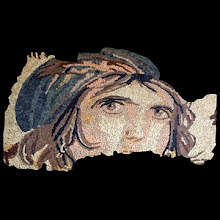
By 200 BC, specially manufactured pieces ("tesserae") were being used to give extra detail and range of colour to the work. Using small tesserae, sometimes only a few millimetres in size, meant that mosaics could imitate paintings. Many of the mosaics preserved at, for example, Pompeii were the work of Greek artists.
The mosaic here shows the god Neptune with Amphitrite (on the right) and is in Herculaneum, Italy. It is a wall mosaic which uses pieces of glass to give the vivid colours and reflect light. Glass was not suitable for floor mosaics. Here, the tesserae were mainly small cubes of marble or other stone. Sometimes bits of potte

No comments:
Post a Comment